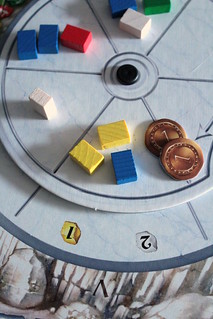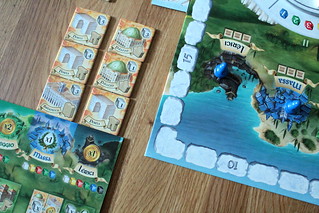| Strategy | Luck |
|---|---|
| Interaction | Components & Design |
| Complexity | Score |

From the title, it’s already pretty clear that this will be a game about marble, because that’s what the small city Carrara in Tuscany, Italy is famous for: just about the finest marble on the planet, quarried since Roman times. Exactly the stuff you would want to build your palaces from. Now here’s a bit of false advertising on the box: you are not exactly doing anything in the city of Carrara, your building activities all happen further down the coast, from Lerici to Livorno. And only one sixth of your construction work goes into Palazzos as well, you also work on Villas, Castellos, Cathedrals. If there was a demand for marble chicken coops, you’d be building them, too – the customer is always right, after all. Anyway, lets not get hung up on the title, you are operating in the area of Carrara and you are building, among other things, palaces.
But mechanically, that covers two thirds of the game already: there are three different actions you can take on your turn, and two of them are buying marble and constructing buildings from it. Of course, none of that is as easy as it sounds. Take the marble market, for example. It’s not as simple as “pay money, take rocks”, the price for each piece of marble decays over time, and you want to grab it when it’s cheap, but before someone else does. This works simple and without bookkeeping by putting the market on a wheel, split into six sectors. Marble enters the market in sector one, where it’s the most expensive: six coins for the good, white stuff and even black marble still costs one. Before you buy, you turn the wheel by one sector (or you decide if you want to turn it with the advanced rules, more on those later) where everything is one coin cheaper – with each sector, more stones are even available for free because their price drops to zero. After turning, you decide on one sector and buy as much as you want from there. Wait long enough, and you get a lot of rock for nothing at all. Or you get nothing, because someone else grabbed it first.

Now, about those advanced rules I mentioned? The Palaces of Carrara comes with two sets of rules: the basic ones and the advanced ones, which are sealed in a forbidden looking sealed envelope with a seal warning you not to open it before you played the basic game at least twice. That’s a bit melodramatic maybe, but it works well for teaching the game. The advanced rules don’t change anything fundamental about the game, but they add some options, like not turning the wheel when buying marble.
Option two on your turn, construction, is not a big, complex operation either, but it has it’s own difficulties. Buildings come in six different types, each type with tiles costing from one to five blocks of marble. However, neither the type of building nor the cost have anything to do with the color of marble needed to build. That depends only on the site: in Livorno you can build in white marble, and that’s it. Anything else is not good enough for these snobs. Going a bit north, to Pisa, they’ll already accept white or yellow. The further north you go, the less picky about their marble the cities become, until finally, in Lerici, they’ll accept any of the six colours. Or granite. Or, if you could spare some pumice, you know, just a little, we could build a Cathedral with that. Lerici will accept anything. It doesn’t sound very realistic, considering the distance between Livorno and Lerici is less than a hundred kilometers, but it really works for the game: it’s always a tough choice if you want to build that 5-cost Library in Massa, with the cheap rocks you still have, or if you spend two more rounds collecting white marble to be able to build it in Livorno. Obviously, in a game that only takes 60 minutes, losing two rounds is not a good thing. And there is no guarantee you get the white, someone might buy it from under you. Decisions, decisions, decisions.

But why do you want to build in expensive Livorno and Pisa so badly, anyway? That’s because the payoff there is much better when you pick the third option on your turn: scoring. Scoring is an interesting affair in The Palaces of Carrara because you do it when you feel like it, with almost no interference from the other players. When scoring, you multiply the building cost of the buildings scored with the value of the city to get your payout, and the cities’ values are higher in the more picky places. Half of them score points (Massa – 1, Lucca – 2, Livorno – 3), the other half earn money (Lerici – 1, Viareggio – 2, Pisa – 3). But nothing is ever easy, you don’t just go and say “score my stuff!” You have to make some more tough choices first. You can chose to pick one type of building, for example all your Castellos. Then each Castello will give you what it’s worth in its location, money or points. But you can only score a type of building once the entire game, so you better pick the right time. Or you could choose to score a city and take the value for all buildings there. But that is even more only once a game. I’d say “oncer”, but I don’t need another Oxford Dictionary Assassin after me. A city can only be scored by one player, and if someone does it before you, that’s just tough luck.
Besides points and coins, scoring your stuff also gives you objects. Yeah, that’s what they are called. No, it’s not very imaginative. But it is what it is, each type of building gives you a different type of object, as long as that type is still available. Those objects do pretty much nothing during the game, but they score points at the end and help you end the game. Because ending the game is, at least to a large degree, in your control. In each game you randomly determine three conditions that a player must meet before he can do so (in the basic game, those are fixed). For example, you might have to score two cities, collect a pair and a quartet of symbols and have four orange buildings built. Then, and only then may you call for the end of the game after taking your turn. The current round is still finished, and then it’s over. Alternatively, the game will end when all the buildings have been built. This level of control over the end of the game gives you interesting options: when you see the other players collecting white and yellow marble to build the expensive stuff, you might just try and meet the conditions quickly with cheap buildings in Lerici and Massa and win the game before anyone else really had a chance to score. Just make sure they don’t beat you in the final scoring, though, because there can be a lot of points in there.

The same cards that dictate the game end conditions tell you how to score points at the end. You might get points for each triplet of objects, for each city with two of your buildings and then score two cities for free. When playing for a quick end, you want to be sure that these points go to you because you might not have any others. But that’s the really cool thing about The Palaces of Carrara with the advanced rules: the cards drawn have a huge impact on your strategy, they change everything. Every game is different because of that. And since those cards are drawn before the game starts and don’t change, they don’t even count as luck, they’re simply different starting conditions to deal with. The only luck involved at all is the new marble entering the market, and dealing with that is part of the fun. Other than that, it’s all strategy in Carrara. Strategy and dealing with the mess the other players make of your plans, because for a game with no direct interaction, there are surprisingly many ways to do that. So, a good, strategic game that plays in an hour. Definitely possible, this one is the proof. The nomination for Kennerspiel des Jahres was well-deserved.














